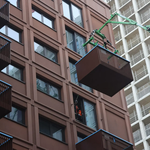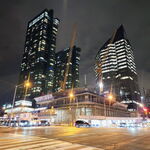Tram-trains to replace UPX? Like trains similar to LRTs using the GO network?
They'll need to be high performing to keep the same timetables. Most tram-trains can't run 140kph, which Both the UPX and BiLevels are capable of reaching. Regularly, Lakeshore West expresses briefly hit 140-145kph -- the whole diesel 12 coach. Tram trains are unable to support this performance so it will could be a light EMU lighter than the BiLevels but heavier than LRVs. There are some routes where tram-trains could make sense but I'm not 100% sure that the GO network could go
that light. Even the non-FRA lightweight EMUs have much bigger structural strength than Flexity Freedoms, and it is possible that Transport Canada may have some kind of a "lite" structural rule, like reinforced shock absorbing bumper pads added to the front/rear of even lighter trains. Admittedly, there are some tram-train LRT vehicles in Europe that goes onto heavy rail corridors and then back onto streets, all with lovely seats, more comfortable than the GO trains, albiet not as comfortable as UPX.
For the transition to EMUs, I am open to ideas, but I have a slightly different vision utilized a unified UPX+RER+ST fleet, as follows:
I see hints of RER Bramalea-Stoufville possibly being destined to eventually (through a series of obvious decisions) gradually merge RER/ST/UPX. Basically a RER with SmartTrack and UPX elements. You just have to look at Paris RER B, as an example (
see earlier post) -- it has an airport spur and every other train goes up the spur.
It would likely use conventional EMUs. Probably a 6-coach EMU for 15-minute offpeak. You could double-berth them during peak. Union Station is a massive bottleneck but let's remember that the Union loiter-space is going to go about 6x as much (3x GO concourse space + the new basement mall). The USRC resignalling will permit increase of trainset count into Union. But as everybody said, one of the bottleneck will be platform stairs and platform capacity, though the considerations for one 12-coach train versus two 6-coach trains would be roughly similar. The double-berth concept is mentioned as one of the many options in some of the Metrolinx documents, including Metrolinx 2031 (albiet using berths west of York when double-berthing longer trains).
There is
Metrolinx advertising that hints of a bilevel EMU. The pictogram, which is clip art and only a concept -- however, is a Stadler KISS, a bilevel EMU available in 6-coach amd shorter. This may not be the ultimate decision, but one of the many 6-coach EMUs (modified with higher-density GO coach seating, rather than first class / second class configuration, to be similar to a 6-coach BomBardier BiLevel) seems to make the most sense for a long-term EMU fleet transition for the GO network.
One big question is whether we'll stick to low platforms, or raise to high platforms. This is also posted in my
Great Platform Height Debate thread. The opportunity exists because UPX brought high platforms AND also SmartTrack requires infill stations. The infill stations can be high-platform only. And this route is the obvious first route for EMUs. Thusly, high platforms cannot be completely ruled out for this one specific route (RER Bramalea-Stoufville with an airport spur).
Possible High Platform Train transition opportunity exists because:
-- UPX brought some high platforms to the GO network.
-- Infill stations could theoretically be high-platform only
-- Choices of electric EMUs are bigger if you also include high platform options
-- Future high speed trains will be high platform (see Ontario high speed train study)
Fate of 12-coach trains on Bramalea-to-Union during transition period to high platforms:
-- After transition, 12-coach trains would cease to stop at Bloor/Weston (12-coaches will go express to Bramalea, for Kitchener all-day service)
-- After transition, Bramalea-to-Union would serve only 6-coach high-floor EMUs
-- UPX Union could relocate to another platform eventually. It could run a shortened 3-or-4-coach version of the same RER EMU, or it could utilize a narrow platform extension eastwards into Union
Possible unified high-floor EMU trainset scenario for RER and UPX fleet
-- Lengthening UPX platforms at Bloor/Weston to 6 coaches.
-- 12-coach trains at Bloor/Weston would only open 9 coaches, during the transition period (before going express when EMU service begins).
(Not enough room for simultaneous 12-coach low platform and 6-coach high platform)
-- Fate of Union UPX station in theoretical unified RER EMU fleet scenario:
......(a) Initially using fewer coaches for trains that stop at Union UPX (up to 4 coach)
......(b) Relocation to regular Union platform
......(c) Or lengthening UPX platform with a narrow raised TTC-style platform eastwards down Track 3.
-- Fate of Pearson UPX station in theoretical unified RER EMU fleet scenario: Unknown, but best-case scenario is that the RER EMU chosen has a bend radius capable of going on UPX spur. Longer RER EMUs could only open the frontmost 3 coaches at the Pearson UPX station. It would be the same 3 coaches that open at the more spacious portion of the Union UPX platform, so airport travellers knows which coaches to board.
If you could pull off a
unified EMU fleet scenario for RER+UPX+ST, you could run almost identically to
Paris RER B as pictured.
Metrolinx/GO would save a lot of money in this EMU unified fleet scenario. Union capacity is a problem, but assuming enough funds were spent to allow enough USRC corridor throughput of individual trainsets, preloading Union (right before peak) full of double-berthed 6-coach trains serving opposite directions. Offpeak when the service frequency was lower, and you don't have to worry about conflicts between incoming/outgoing trains, you can run several routes as through service (e.g. Bramalea-Stoufville). Today, Lakeshore runs this way (LSE-LSW runs through service mainly offpeak) and the same could concievably happen to the route that got the SmartTrack brand.




